Renny Harlin: Swimming With Sharks
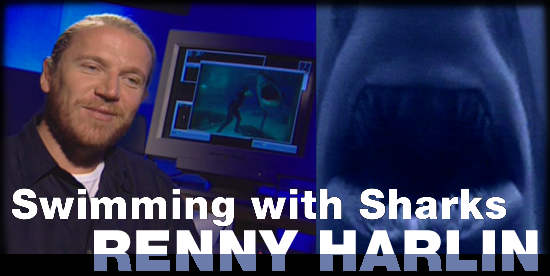
With “Deep Blue Sea”, Finnish director Renny Harlin took a plunge into effect’s heavy waters and also returned to his roots in the horror genre.
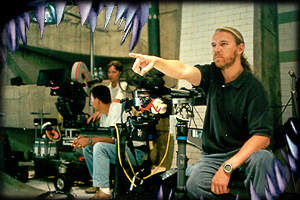 With nice regularity filmmakers try their skills on shark movies, a genre that has never died since Stephen Spielberg introduced audiences to “Jaws”. In its most recent incarnation, director Renny Harlin took the plunge and launched a massive shark attack on moviegoers this summer. Now, his film “Deep Blue Sea” has made its debut on DVD, where it will certainly scare more than just a few people. And all that just when you thought it was safe again to go back into the water…
With nice regularity filmmakers try their skills on shark movies, a genre that has never died since Stephen Spielberg introduced audiences to “Jaws”. In its most recent incarnation, director Renny Harlin took the plunge and launched a massive shark attack on moviegoers this summer. Now, his film “Deep Blue Sea” has made its debut on DVD, where it will certainly scare more than just a few people. And all that just when you thought it was safe again to go back into the water…
Unlike “Jaws”, “Deep Blue Sea” uses a very different outset for its horrors. Despite a freely roaming individual shark, the film presents us with three representatives of the species in what should have been a clinically controlled environment. But before you know it, the sharks wreak havoc in “Aquaria”, the research facility they are held in. Using the sharks to extract a protein that can help heal Alzheimer’s disease, one of the scientists went a step too far by genetically engineering the sharks for larger brain mass to obtain more protein. As a result suddenly the sharks begin use their brains to hunt down and stalk their human prey with horrifying cleverness.
In preparation for this film project, director Renny Harlin decided to take a look and experience sharks for himself. In Stewart’s Cove in the Bahamas he went underwater to meet with some of the most perfect and oldest killing machines nature has to offer. “I learned to scuba dive for this movie,” Harlin remembers as talk about his latest movie. “I have always been apprehensive about what might lie down there in the dark. To overcome this feeling I dived with sharks and was mesmerized by the world underneath. We were diving with sharks in the Bahamas with some 30 sharks, raging from 6 to 12 foot in length. It was exciting! You just don’t realize when you’re under water that you’re running with a pack of tigers. At first we started in a cage feeding tuna to them. But after a while that experience just wasn’t enough any more and we got out of the cage to mingle with them.”
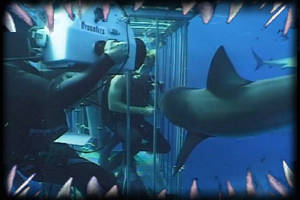 His excursion into the realm of sharks also gave Harlin the chance to take capture some visuals in his mind that would help him bring the film to life. One thing he knew from the beginning of the project was that he needed to set “Deep Blue Sea” apart from “Jaws”. Any comparison with Steven Spielberg’s masterpiece would inevitably cause a bias towards the established and highly acclaimed cult film, and may distract from the fact that “Deep Blue Sea” is actually a very different tale. As a result, Harlin and his crew took some conscious steps to differentiate themselves from other shark movies.
His excursion into the realm of sharks also gave Harlin the chance to take capture some visuals in his mind that would help him bring the film to life. One thing he knew from the beginning of the project was that he needed to set “Deep Blue Sea” apart from “Jaws”. Any comparison with Steven Spielberg’s masterpiece would inevitably cause a bias towards the established and highly acclaimed cult film, and may distract from the fact that “Deep Blue Sea” is actually a very different tale. As a result, Harlin and his crew took some conscious steps to differentiate themselves from other shark movies.
I learned to scuba dive for this film
“From the beginning when I received the script I thought I can’t do anything that’s considered a ‘Jaws’ rip-off,” the director confides. “As a result I got into helping to develop the script, always being aware of the ‘Jaws’ factor. We always tried to find a different kind of approach. The first big difference was that we had to make sure we have the technical ability to show off the sharks.”
“Jaws” used to have serious problems with the animatronic shark “Bruce” during the film’s production 25 years ago. As a result, the movie gives the viewers only brief glimpses of the fish, masterfully edited together from thousands of feet of footage that did not work convincingly for the most part. Harlin on the other hand had a different vision. “We wanted viewers to see the sharks a lot. We needed to show their speed, their power and their grace. Ultimately, computer generated sharks were the solution.”
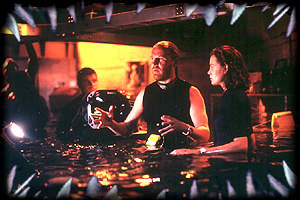 Harlin also had moments where he stepped back, looking at the approach, and decided that they had to come up with something different in order to give “Deep Blue Sea” its own signature. “With ‘Deep Blue Sea’ I tried to break the clichés of horror films,” the friendly explains. “We created certain scenes to really surprise the audience so that they are off-balance. I think audiences are so well educated today that they are not easily fooled.”
Harlin also had moments where he stepped back, looking at the approach, and decided that they had to come up with something different in order to give “Deep Blue Sea” its own signature. “With ‘Deep Blue Sea’ I tried to break the clichés of horror films,” the friendly explains. “We created certain scenes to really surprise the audience so that they are off-balance. I think audiences are so well educated today that they are not easily fooled.”
With Deep Blue Sea I tried to break the clichés
While “Jaws” used a Great White Shark as the monstrous threat, Harlin and his crew decided early on to use a different kind of shark for their movie. Eventually they decided to use Mako sharks that have a very different look from the Great White that has become such a stereotype.
“We wanted to have a different type of a shark,” Harlin tells me. “One that’s known for its speed, one that has a different look and different teeth. The rosebush of teeth that stick every which way are a great visual and we really wanted to get away from the “Jaws” look.
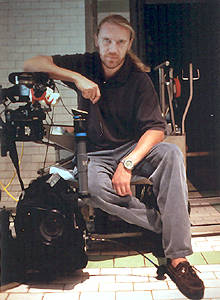 Shot on the Fox Studios Baja set that was built for James Cameron’s “Titanic”, the state-of-the-art studio gave Harlin all the control he needed to flood areas of the set, and to avoid a strong dependency on actual weather conditions. But apart from these controlled environment flooding effects the facility offered, “Deep Blue Sea” also relies heavily on a variety of other effects, ranging from animatronic life-size sharks to fully computer rendered scenes. To coordinate a shoot of those proportions, careful organization is necessary as Harlin explains. “I plan everything very carefully,” the young director says. “I storyboard the entire film. During the production I had all 3000 shots of the movie illustrated and put them on the wall. I also distributed them to all the members and had everyone sharing it so that everybody knew exactly what we were trying to do.”
Shot on the Fox Studios Baja set that was built for James Cameron’s “Titanic”, the state-of-the-art studio gave Harlin all the control he needed to flood areas of the set, and to avoid a strong dependency on actual weather conditions. But apart from these controlled environment flooding effects the facility offered, “Deep Blue Sea” also relies heavily on a variety of other effects, ranging from animatronic life-size sharks to fully computer rendered scenes. To coordinate a shoot of those proportions, careful organization is necessary as Harlin explains. “I plan everything very carefully,” the young director says. “I storyboard the entire film. During the production I had all 3000 shots of the movie illustrated and put them on the wall. I also distributed them to all the members and had everyone sharing it so that everybody knew exactly what we were trying to do.”
His organizational and preplanning skills have obviously paid off, as Harlin and his team were able to bring in “Deep Blue Sea” slightly ahead of schedule and under budget—a very rare commodity in today’s Hollywood.
“It is important that everybody on he project knows what I’m after. I really enjoy going to the set knowing what to do. Every night before I go to bed I usually make a complete list of shots for the next day. So the night before, I would always know exactly what to do, distribute the material to the people, and then cross it out as we go along every day.”
Renny Harlin also a very fast shooter which allows him to work on rather tight shooting schedules. “I use a lot of cameras and never do under 30 set-ups a day, sometimes even 60. That is very fast and doesn’t leave room for many takes. I rehearse a scene, shoot it and after about three takes I’m done. For my experience, it is important that the director defines the pace on the set. If he allows himself too much time, the crew gets bored because they don’t have anything to do, really. Usually they want to do things though, and it’s not got to force them to sit around.”
Unlike many other directors who spend a lot of time redoing shots over and over again looking for the perfect take, Harlin’s approach gets him results quick. He also uses an extensive camera set up that gives him plenty of footage to work with in the editing stage of his film. “I shoot easily million feet of film and then edit it together. I like getting the coverage from all kinds of angles and then build a scene in the editing room.”
When I realize it’s panned, I immediately turn it off!
Apart from the big screen presentation during a movie’s box office run, the home video and TV release is also of great significance today. Sadly however these releases are often presented in altered versions, including cropped pan & scan transfers. “I feel its unfortunate,” Renny Harlin describes the situation. “I understand that a lot of people have small TV sets and what to see the image fill their screen, but every time I see a movie on cable and I realize it’s a panned or blown-up version, I almost always shut it off. I know how different the experience is, and for me, it important to see the original intention. Pan & scan just takes so much away from that. Usually I wait until I have access to a letterboxed version.”
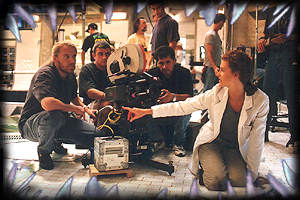 Renny Harlin is also an avid DVD fan from the medium’s earliest days with a collection of about 250 titles. “The experience of DVD is great,” he enthuses. “I actually have a couple of DVD payers. There are 2 in my house and one in my office. I’m a real fan! I’ve had DVD for about two-and-a-half years already. I got into it from the very beginning. I also have a Laserdisc collection of 500 discs, but sometimes those seem to me as if I’m this really old person with an old Vinyl collection,” he laughs.
Renny Harlin is also an avid DVD fan from the medium’s earliest days with a collection of about 250 titles. “The experience of DVD is great,” he enthuses. “I actually have a couple of DVD payers. There are 2 in my house and one in my office. I’m a real fan! I’ve had DVD for about two-and-a-half years already. I got into it from the very beginning. I also have a Laserdisc collection of 500 discs, but sometimes those seem to me as if I’m this really old person with an old Vinyl collection,” he laughs.
Usually Harlin shoots his movies on a film format that is known as Super 35. Unlike some other widescreen formats, Super 35 allows the filmmaker to arbitrarily decide upon an aspect ratio. The entire negative is exposed and only later soft matted during the film’s presentation in theaters. As a result, films that were originally shot in Super 35 can be presented in open open matte transfers for fullscreen home video presentations without cropping the image, actually revealing additional picture information at the bottom and top of the frame. Shooting in Super 35 is a deliberate attempt by Harlin to get the best out of his films when they finally make migration to television sets. “Open matte is much better than pan & scan,” he adds. “My decision to use Super 35 does have to do with that. Sometimes I can’t really shoot for a fullframe presentation—there might be something above the letterboxed frame that’s going to show up when I open the matte. In those instances I have to do a blow up here and there, but mostly using an open matte transfer is the better of the two evils.”
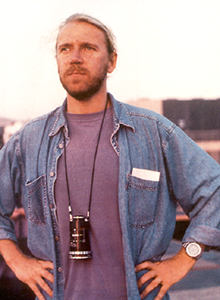 But even DVD and Laserdisc have changed the director’s approach to his work, making him more sensible to the capabilities of these formats and the expectations that arise with them. “I have had these things in my mind since I’ve been doing the Laserdisc for “Cliffhanger” in 1992, and I do it now too,” reports Harlin. “On the set I have usually people and assistants shoot a lot of behind the scenes footage. That way I can include as much as possible on a DVD release. It’s really exciting to see how this home theater thing has taken off. Many people have a rather small TV but with good speakers, and it seems people have gotten into the whole home theater experience. And DVD is a fantastic way to watch movies at home.”
But even DVD and Laserdisc have changed the director’s approach to his work, making him more sensible to the capabilities of these formats and the expectations that arise with them. “I have had these things in my mind since I’ve been doing the Laserdisc for “Cliffhanger” in 1992, and I do it now too,” reports Harlin. “On the set I have usually people and assistants shoot a lot of behind the scenes footage. That way I can include as much as possible on a DVD release. It’s really exciting to see how this home theater thing has taken off. Many people have a rather small TV but with good speakers, and it seems people have gotten into the whole home theater experience. And DVD is a fantastic way to watch movies at home.”
The film turned out pretty much the way I had envisioned it
“At home” are the operative words here. Like many people, despite the rise of home theaters, Harlin believes nothing can replace the atmosphere and experience of seeing a movie in a movie theater. “No, no matter what the technology, or how good the quality of home theater equipment is, people always want to go to the theater. People still buy beer in liquor stores, although you can easily buy a six pack in your local supermarket, and at the same time you still want to go out to a bar for a beer. Going to a theater with other people is something people want to do.”
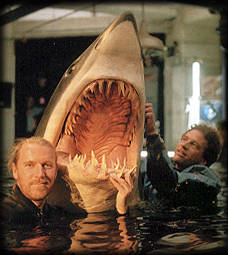 Renny Harlin was also very involved in creating the DVD release for “Deep Blue Sea”, choosing all the extras, the footage, and the storyboards that went on the release as supplements and recorded a commentary track for the disc, something he enjoyed greatly. Although he did not many commentary tracks before, it has nothing to do with a general apprehension the way it can be found in numerous other directors.
Renny Harlin was also very involved in creating the DVD release for “Deep Blue Sea”, choosing all the extras, the footage, and the storyboards that went on the release as supplements and recorded a commentary track for the disc, something he enjoyed greatly. Although he did not many commentary tracks before, it has nothing to do with a general apprehension the way it can be found in numerous other directors.
To make sure the visual presentation on the DVD comes across as good as possible, he also ensured the transfer was done right. “We went through the scenes very carefully,” he reports. “They did a beautiful job with the transfer. It’s always a triocky thing, especially with the many blue tinges we have in ‘Deep Blue Sea’. It is a matter of keeping it dark, but not too dark. I’m very happy with the way it turned out.”
Although “Long Kiss Goodnight” is the film, Renny Harlin is the most proud of in terms of the story and characters themselves, “Deep Blue Sea” is a project that took him to new territory and fills him with pride. “Technically it is an incredibly difficult movie,” explains the director. “The shoot and all the CGI work, the sharks and the water. The way we did it, it had never been done before. I’m very happy that the film turned out pretty much how I had envisioned it.”


Leave a comment
You must be logged in to post a comment.